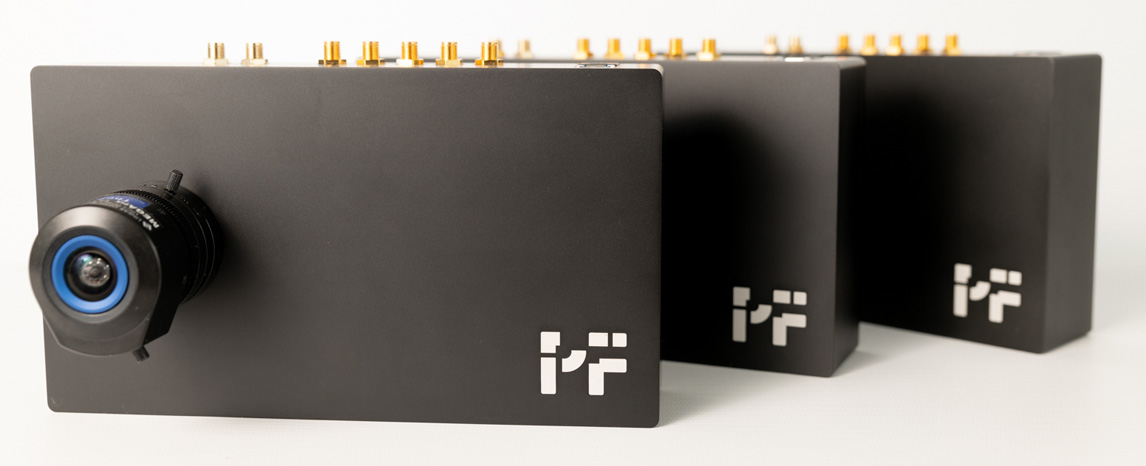Videos
Loading the player ...
- Offer Profile
- ´
An SME Focused on Photon-Counting
光子力近期启动in the image sensing community, building on the EC FP6 Funded Megaframe project and over a decade of successful research experience in time-resolved imaging from the CMOS Sensors & Systems Group at the University of Edinburgh. Our mission is to provide innovative, high quality, and accurate sensor technology to facilitate research, with an initial focus on the biomedical field. Until now, single photon detection and timing capabilities have only been available as separate, bulky, and low-throughput pieces of equipment. Our products help speed up the research process by streamlining these features into a single, simple unit, easily integrated into your existing lab setup.
Product Portfolio
PF32 Time-Correlated Single-Photon Counting Camera

-
- 32×32 Time Correlated Single Photon Counting (TCSPC) pixel array.
- Fully digital photon counting and timestamping (no analogue readout noise).
- Wavelength response available on request.
- In-pixel dual mode electronics:
- 55 ps resolution 10-bit Time to Digital Converter (TDC) time-stamping (1,023 time bins).
- 7-bit photon counting.
- Pipelined operation: simultaneous data acquisition and readout (no inter-frame dead time).
- Up to 300k frames/s transfer to PC via USB3 (dependent on mode and bit-depth of data).
- Instrument response function ~ 150 ps.
- Programmable region of interest (permits higher frame rate for subset of pixels).
- Flexible readout timing (permits higher frame rate for reduced number of counter/TDC bits).
- External laser synchronisation input to provide TDC stop signal.
- Laser synchronisation output (for laser as slave operation).
- Single 5V power supply (included).
- Precision-machined aluminium enclosure (CS-Mount for lenses).
-
Applications
-

Showcase of the PF32's Impact
-
- The PF32 system has been used in a wide range of research activities.
- Fluorescence Lifetime Imaging
- Tracking Hidden Objects
- Imaging through Scattering Media
- Imaging Light in Flight
-

Fluorescence Lifetime Imaging
-
- No more scanning: time-resolved measurements with an array of single-photon detectors.
FLIM and FRET imaging traditionally use scanning systems to form an image of the sample under test. With the PF32, however, an image is formed without the need for scanning thanks to the 32 x 32 array of SPAD detectors in the sensor. The following video is an excerpt from S. Poland’s paper, although this took advantage of scanning the array for a further increase in speed and resolution.
The left shows intensity, the middle is lifetime, and the right is a combination of both.
-

Tracking Hidden Objects
-
- 单光子敏感捕捉triple-scattered light, and 55 ps timing resolution enables accurate locating of hidden objects.
Researchers at the University of Glasgow and Heriot-Watt University (Edinburgh, Scotland) used the PF32 to capture photons that had interacted with an object hidden from direct line-of-sight. The top figure shows the experimental setup, whilst the video shows tracking of the object at 3 second intervals.
-


Imaging through Scattering Media
-
- Using time-resolved data to predict an object’s form behind a scattering medium, or ballistic photons to image through tissue.
Researchers at MIT have used deep learning on time resolved data from the PF32 camera in order to predict an object’s form behind a scattering surface. The figure below shows (a) the training of the computer neural network (CNN) and (b) the physical setup of the pulsed laser and PF32 camera.
By analysing (a) the time-resolved data from the PF32 of an unknown object form, the authors were able to (b) predict the classification of the toy’s pose with a high degree of accuracy as shown the figure below.
-

Imaging Light in Flight
-
- The PF32 has such precise timing precision that you can watch light as it travels.
Visualising processes that occur in the nanosecond time-regime is no problem for the PF32’s 55 ps time resolution. In the video below, researchers from Heriot-Watt University and the University of Glasgow have captured light in flight – individual photons scattered by molecules in the air were detected by the PF32 camera. The data was then interpolated to increase the resolution and overlaid on a background photograph.
In the same paper, they use a similar method to capture plasma creation in air. This time the process was filmed with two different optical bandpass filters, one to record the laser, and one to record the plasma generation. Analysis of the exponential lifetime decay of the plasma shows the results are consistent with previously reported values. Quoting the paper: “It is important to note that the technique described here allows to characterize the plasma dynamics without the need to introduce any additional scattering agents, which would severely alter the plasma formation process itself.”









